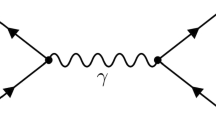Abstract.
The characteristic of bound-state, Bethe-Salpeter equations that makes them so difficult to solve numerically can be overcome, in some if not many cases, by expanding solutions in terms of basis functions that obey the boundary conditions that are satisfied by the solutions. The utility of such basis functions is demonstrated by calculating the zero-energy, bound-state solutions of a spin-0 boson and a spin-½ fermion with unequal masses. The constituents interact via scalar electrodynamics and are described by the Bethe-Salpeter equation in the ladder approximation. Although the Bethe-Salpeter equation that is solved is separable in the zero-energy limit, the feature that typically prevents solutions from being obtained numerically is still present. A technique for calculating boundary conditions, which is readily generalized to other Bethe-Salpeter equations, is discussed in detail.
Similar content being viewed by others
Author information
Authors and Affiliations
Corresponding author
Additional information
Supported by a grant from the Ohio Supercomputer Center
Received January 31, 2003; accepted April 4, 2003 Published online August 25, 2003
Rights and permissions
About this article
Cite this article
Mainland, G. The Importance of Boundary Conditions in Solving the Bound-State Bethe-Salpeter Equation. Few-Body-Systems 33, 71–88 (2003). https://doi.org/10.1007/s00601-003-0007-1
Issue Date:
DOI: https://doi.org/10.1007/s00601-003-0007-1




